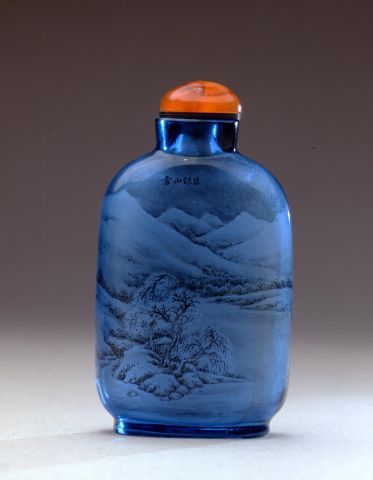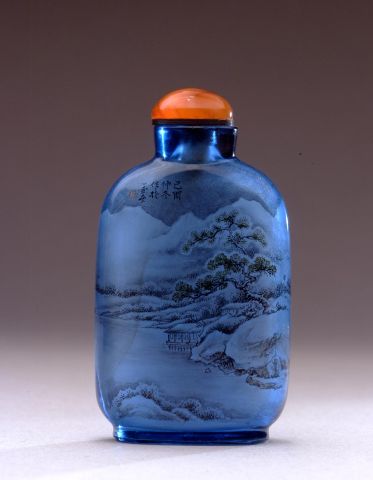

Bottle ID: 00386
WANG XISAN, BLUE W/SNOWY LANDSCAPE SCENE & INSCRIPTIONS
Date: 1969
Height: 61 mm
Glass, ink and watercolors, of rectangular form with sloping shoulders, the blue body painted on the inside with a continuous scene of pavilions nestled amongst trees by an icy lake in a snowy mountainous landscape, inscribed on one side 'Made at the Yihu Zhai (The One Bottle Studio) in the Second Month yiyou (1969) year', the reverse with the title 'Dressed Up In Silver - Mountain Snow', with one illegible seal.
Similar Examples:
None found.
Provenance:
The White Wings Collection.
Exhibited:
Annual Convention ICSBS Toronto, October 2007
Published:
Kleiner, Robert. Chinese Snuff Bottles - The White Wings Collection, 1997, p. 293, no. 208.
Wang Xisan (b. 1938) painted a series of winter scenes in 1969 (see also Crane 647 and 904), and this may have been a way for him to express his feelings during the Cultural Revolution. Wang (whose former name was Wang Ruicheng) began painting in 1957 under the pupilage of the Ye brothers, Ye Xiaofeng and Ye Bengqi. He quickly surpassed them through both his ability and his artistic talent and by 1962 at his studio, Peaceful Hamlet, began to paint some of his finest work. The Ye brothers had become purely commercial by the fifties and Wang is credited with bringing inside painting nearer to its origins. Wang was banished in August 1966 from Beijing to Hebei Province where his family had come from and was forced to work as a peasant farmer by the Commune. He took with him three blank bottles hidden in his bedding, which he painted and used to persuade the management of the Commune that he could make more money for them by selling these than by farming. They allowed him to travel to Tianjin, where he posed as an agent for the painter and quickly sold the three inside painted bottles. Gradually he was allowed to give up farming and continued to paint for the Commune. A trip to Beijing to appeal his exile in 1967 failed and he remained in Hebei Province. Despite the trials of the Cultural Revolution and its attendant hardships, Wang's art was highly creative and technically skillful at this time and into the 1970's because he did not have the additional burdens of teaching and of a commercial output.
In 1969, he began using the studio name Yihu Zhai (One Bottle Studio). Prior to 1966, Wang had often used older bottles in different materials such as crystal, agate and amber to evoke a mood or to make the bottle itself part of the painting. In the case of this bottle, though it is not old, he has done just that. The blue glass creates an effect of the snowy crisp landscape bathed in moonlight as though Wang has captured that moment in winter when everything is still and nothing seems to move, as though he was waiting for something to happen. The Cultural Revolution ended officially the same year (although in reality it dragged on until 1976) and it is natural to interpret these scenes as being symbolic of the end of an era.
< Back to full list

 English
English 中文
中文